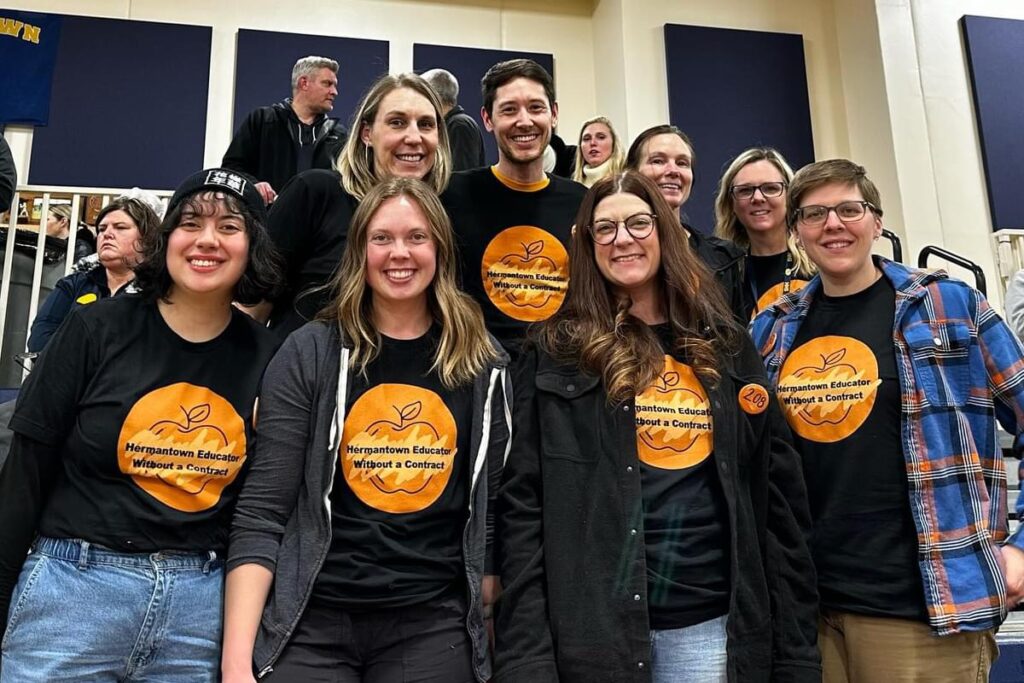More Education Minnesota locals across the state have been taking action around demanding 2023-25 contracts that respect and honor their work than in any other bargaining round in recent history.
With the historic investments from the Legislature and the educator shortage affecting nine out of 10 Minnesota schools, local unions have been bargaining more boldly and trying new tactics around organizing and communicating within their locals and worksites to engage members.
Leaders from Anoka Hennepin Education Minnesota and Education Minnesota, Hermantown shared their “why” around increased member action around bargaining with the Minnesota Educator.
Anoka Hennepin Education Minnesota
Anoka Hennepin Education Minnesota had two goals going into negotiations, said John Wolhaupter, the union’s lead negotiator.

The first goal was to recruit and retain a highly qualified education workforce, and the second was to create an environment of welcoming, healthy and supportive schools and programs throughout the district.
“Each of these goals had several more specific goals nested within it,” he said. “Our work as a team tied back to the two goals as we met with members and designed proposals. The first goal in particular tied back to a question on our negotiations survey that showed 12% of our members were actively looking at careers outside education. Having this information and these goals gave the team and members a way to communicate what we were trying to accomplish at the bargaining table.”
The negotiations team in AHEM started intentionally planning for this bargaining round right after the last one to not only prepare as a team, but to start working with all of their members around being an active part of the process.
“We met as a team regularly during the 2022-23 school year to plan, gather information from members and to start developing proposals we wanted to make,” Wolhaupter said. “Prior to the start of bargaining, we started having weekly informational pieces in our local newsletter. Early in the process, these articles highlighted different areas of the contract, especially those that were not well understood by members or were areas of focus for the upcoming round of bargaining.”
The team also made the intentional choice to communicate as much as possible with members and bring them along throughout the entire bargaining process.
“As we started meeting with the district in the summer, a few members attended sessions as observers. We also shared the specific contract language proposals that both sides made with members,” Wolhaupter said. “When the school year started, we had several sessions with the district during the day when members could not attend, so when we started discussing financial offers in more depth, we shifted to evening sessions and invited members. By this time, the various proposals made by the district had energized members and we had tremendous turnout at these open bargaining sessions.”
As time went on, the negotiations team knew they needed to escalate their organizing and communications. The local was close to authorizing a strike vote but reached an agreement in mediation right before that authorization was scheduled to take place.
The negotiations team started hosting weekly Zoom webinars where they could share out the most recent information and have members be able to ask questions, especially as it related to tactics such as “work to rule,” or working just their contracted hours, and what a strike could look like.
Having a separate Local Contract Action Team who were organizing events like school board rallies and organizing members in buildings was key to the local’s success in engaging with members, said Wolhaupter.
“Having a separate group taking on these responsibilities allowed the bargaining team to focus on the work that needed to be done at the bargaining table,” he said. “We were more successful in communicating with members and getting people out to events by having people with direct information about what was going on at each building.”
Members worked hard to build communication structures in their buildings. Each of the 53 sites had a building represenatative, an organizing committee represenatative, a strike captain, a communications captain and one strike leader for every 10 members.
The organizing committee met weekly during December and January to determine if the local was ready to move forward based on participation in structure tests, such as attending informational picketing with the community, attending rallies, signing petitions and taking a strike pledge.

“Members feel more connected to and aware of the work that is being done on their behalf. Through this round of bargaining, we have established structures that will be helpful as we continue to address member needs,” said Wolhaupter. “All that member organizing and activism resulted in a contract that made significant improvements in compensation and benefits. We still have a lot of work to do in future rounds of bargaining, but this contract includes significant achievements that will have a positive effect on members’ work experience for years to come.”
The contract includes salary increases of 5% in 2023 and 3% in 2024; health insurance district contribution increases for both single and family of 5% in 2023 and 5% for single and 10% for family in 2024; condensing the salary schedule, including bringing up the starting salary to $50,000; and adding Early Childhood Family Education teachers onto the K-12 teacher salary schedule.
Wolhaupter said the local also plans to continue their transparent communication during future bargaining cycles.
“Being transparent with members and sharing as much information as possible throughout the process is an important step forward,” he said. “Members are much more invested in the process and the outcome when they can see the work that is being done on their behalf. Ultimately, the work is being done for the members, so giving them as much access to what is going on is a way to bring their power to the bargaining table with us.”
Education Minnesota – Hermantown
The Hermantown local union consists of both teachers and education support professionals, but while the ESP unit was having a better experience at the table, the teachers were not and they knew they needed to start engaging members, said Katie Marciniak, local union president.

“Our local has been fairly sedentary and with the unique combination of the fund balance and legislative increases, we had to strike while the iron was hot,” she said. “Knowledge is power, and once people understood the financial position our district was in, they were fit to be tied. Our job was to channel those feelings in a productive way and we did that by changing our approach to bargaining.”
The local put out the information that the district was sitting on nearly $7 million in unallocated funds and started an open communication system of sharing out negotiations updates.
“We were extremely open; sending video updates to members after nearly each meeting then engaging members to host informational pickets which in turn engaged the community in attending and speaking out at board meetings,” said Marciniak.
Hermantown used funds from Education Minnesota’s relational organizing grant and organizing for settlement grant programs to help support their efforts, including creating—and paying stipends for—an organizing committee. The committee includes four lead roles with at least six additional building representatives sharing the load.
“In my 10 years here, I’ve never seen much more than the executive board and negotiators involved in union action,” said Marciniak.
The response from members was enthusiastic, said Marciniak, and the local made sure they were documenting what was working and why.
“We began data tracking attendance and making specific requests of members; using the strength of who was showing up and having one-on-one conversations with the less engaged,” she said.
Member engagement around negotiations grew rapidly.
Education Minnesota, Hermantown members had shirts made regarding their unsettled contract and wore them to events to help spread the word about the need for more community engagement in their bargaining fight.
“Teacher attendance at board meetings rose to 25% in early December then nearly 40% in late December. When calculating both in-person and online engagement during negotiations, teacher attendance/ engagement increased by 69%. In regard to other activities, 81.2% of teachers responded to contract negotiations surveys; 71.8% of teachers attended our “Slice and Strike Q&A” pizza buffet on Jan. 15; and 77% were wearing their button saying the number of days without a contract on a daily basis,” said Marciniak.
The local used the Remind app during negotiations meetings to send updates and seek real-time input from members.
The teacher group’s biggest negotiations asks were around health insurance contributions. They secured an increase in the district’s contribution to the family premium, from 35% to 65%. Their contract also includes salary increases of 6% in 2023 and 3% in 2024 and a reduction in the number of salary steps.
Hermantown hopes to continue the momentum they built for future negotiations rounds and all union activities. They recently received Education Minnesota’s We Are One Solidarity Award in recognition of their efforts.
“We hope our local continues to stay engaged in future rounds and beyond,” said Marciniak. “The work never stops, really, and the more you can share the load and tap into people’s strengths and interests, the less cumbersome and overwhelming the work becomes.”


